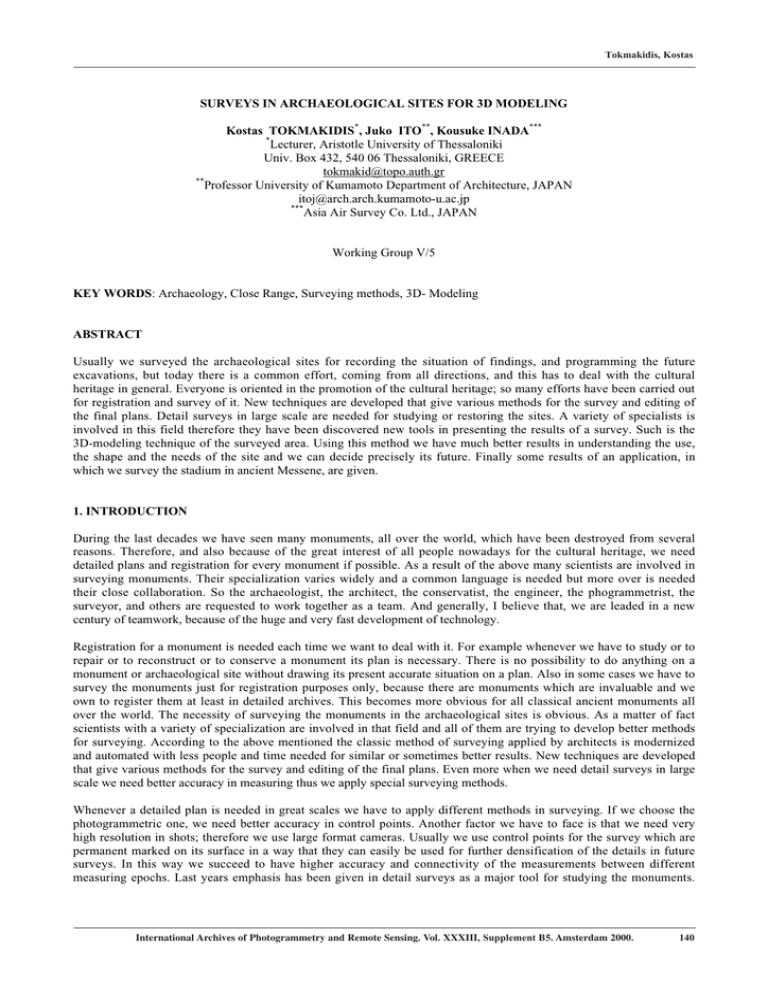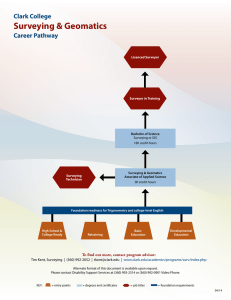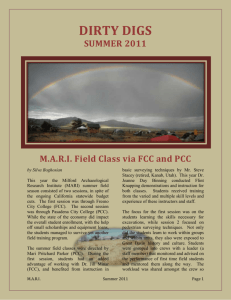SURVEYS IN ARCHAEOLOGICAL SITES FOR 3D MODELING Kostas TOKMAKIDIS
advertisement

Tokmakidis, Kostas SURVEYS IN ARCHAEOLOGICAL SITES FOR 3D MODELING Kostas TOKMAKIDIS*, Juko ITO**, Kousuke INADA*** * Lecturer, Aristotle University of Thessaloniki Univ. Box 432, 540 06 Thessaloniki, GREECE tokmakid@topo.auth.gr ** Professor University of Kumamoto Department of Architecture, JAPAN itoj@arch.arch.kumamoto-u.ac.jp *** Asia Air Survey Co. Ltd., JAPAN Working Group V/5 KEY WORDS: Archaeology, Close Range, Surveying methods, 3D- Modeling ABSTRACT Usually we surveyed the archaeological sites for recording the situation of findings, and programming the future excavations, but today there is a common effort, coming from all directions, and this has to deal with the cultural heritage in general. Everyone is oriented in the promotion of the cultural heritage; so many efforts have been carried out for registration and survey of it. New techniques are developed that give various methods for the survey and editing of the final plans. Detail surveys in large scale are needed for studying or restoring the sites. A variety of specialists is involved in this field therefore they have been discovered new tools in presenting the results of a survey. Such is the 3D-modeling technique of the surveyed area. Using this method we have much better results in understanding the use, the shape and the needs of the site and we can decide precisely its future. Finally some results of an application, in which we survey the stadium in ancient Messene, are given. 1. INTRODUCTION During the last decades we have seen many monuments, all over the world, which have been destroyed from several reasons. Therefore, and also because of the great interest of all people nowadays for the cultural heritage, we need detailed plans and registration for every monument if possible. As a result of the above many scientists are involved in surveying monuments. Their specialization varies widely and a common language is needed but more over is needed their close collaboration. So the archaeologist, the architect, the conservatist, the engineer, the phogrammetrist, the surveyor, and others are requested to work together as a team. And generally, I believe that, we are leaded in a new century of teamwork, because of the huge and very fast development of technology. Registration for a monument is needed each time we want to deal with it. For example whenever we have to study or to repair or to reconstruct or to conserve a monument its plan is necessary. There is no possibility to do anything on a monument or archaeological site without drawing its present accurate situation on a plan. Also in some cases we have to survey the monuments just for registration purposes only, because there are monuments which are invaluable and we own to register them at least in detailed archives. This becomes more obvious for all classical ancient monuments all over the world. The necessity of surveying the monuments in the archaeological sites is obvious. As a matter of fact scientists with a variety of specialization are involved in that field and all of them are trying to develop better methods for surveying. According to the above mentioned the classic method of surveying applied by architects is modernized and automated with less people and time needed for similar or sometimes better results. New techniques are developed that give various methods for the survey and editing of the final plans. Even more when we need detail surveys in large scale we need better accuracy in measuring thus we apply special surveying methods. Whenever a detailed plan is needed in great scales we have to apply different methods in surveying. If we choose the photogrammetric one, we need better accuracy in control points. Another factor we have to face is that we need very high resolution in shots; therefore we use large format cameras. Usually we use control points for the survey which are permanent marked on its surface in a way that they can easily be used for further densification of the details in future surveys. In this way we succeed to have higher accuracy and connectivity of the measurements between different measuring epochs. Last years emphasis has been given in detail surveys as a major tool for studying the monuments. International Archives of Photogrammetry and Remote Sensing. Vol. XXXIII, Supplement B5. Amsterdam 2000. 140 Tokmakidis, Kostas Also detailed plans are used for 3D reconstruction in a computer graphic environment that is valuable for restoring the monuments. On the other hand the cost that concerns both time and money has been eliminated in the modern methods of surveying. This is because of the automatization in many steps in both field and office work. Even though the cost of the initial instrumentation is higher it is worthy because you have the payback mach more soon. Many new techniques have been developed for surveying monuments during the last years. There are at least four reasons, which cause this fact: a. The development of instrumentation in surveying b. The development of computers which automated most of the work c. The development of photogrammetric instrumentation from analog plotters to the digital plotters d. The remarkable acceptance of archaeologists for the new technology The new techniques depended upon the size of the monument, the scale of surveying and the required accuracy. Most of the new techniques are based on photogrammetry, even though surveyors have yet the responsibility for target control points establishment. Photogrammetric surveys depended on the accuracy of control points, which observed with classic surveying methods using total stations or with GPS. The density of control points depends upon the scale. The accuracy of the control points depends on the method of their determination and the accuracy of measuring instruments. Another applied classification deals with the type of the used camera, which could be metric, semi-metric or non-metric and also CCD digital camera. The number of required control points depends also on the type of the camera and the method of solution for extracting the final results. Apart from all of the above we use many types of platforms to take the proper shots, such as kites, balloons, grains, model helicopters etc. in order to carry the camera at the appropriate distance from the object we want to survey (Y. Miyatsuka, 1996). After that we have the choice to manipulate the images in many different ways with several programs in order to obtain the final results. The conclusion is that more easily with fewer hours and less people we can have valuable results, which have much accurate information. 2. PRESENTATION TECHNIQUES As mentioned above the development of computers caused in a way the development in surveying instruments. But moreover this caused the ability of designing and drawing plans in the computer environment. The CAD programs are of a major help for all specialists dealing with the cultural heritage. Those programs have been renewed and their abilities became extremely helpful for the surveyor. For example several years ago there was not possible to define a volume between two not similar surfaces, now this is possible due to the CAD programs development. That fact was causing the impossibility to create sections of the surface automatically. In addition to the powerful CAD programs we had the development of the stereo plotters which lead photogranmmetry into the digital darkroom (Patias 1991). Today both hardware and software in this section are developed and is subject of changing very often towards better solutions. Using CAD programs we can easily produce 3D plans of the buildings and findings in the excavation as mentioned for city plans (Gruen 1998). This is a powerful tool for architects when they wand to visualize the site (Ito et al 1998). Such 3D drawings can have several applications. But accordingly to the huge development of technology in all areas there has observed a difficulty in following and learning all the changes. Hardware and software is changing and developing every day. This will lead to new young people who have a better efficiency in the modern technology and a greater level of understanding it. Recently it has been easily succeeded to draw 3D models of the monuments and sites because of the H/W and S/W development. A 3D model of one site is useful for four reasons: • Better viewing of the site as it was • Understanding of the site and its functionality • Studying the shapes of the site • Designing the reconstruction plans It is obvious the fact that the 3D model gives us the ability to recognize the typical basic building blocks of the monument and their location in the site; in a way to predict their original connection with the monument. Having this information architects face a much easier problem than it was in the past. In the next paragraphs we can see an example concerning the survey of the ancient stadium in Messene. Due to the limited space you will be able to see just some general views of the 3-D model that has been achieved from the photogrammetric survey of the site. The model has been produced in AutoCAD Land Development 2000 environment and it is possible to rotate it, zoom it and manipulate it in many different ways. 141 International Archives of Photogrammetry and Remote Sensing. Vol. XXXIII, Supplement B5. Amsterdam 2000. Tokmakidis, Kostas 3. THE ARCHAEOLOGICAL SITE OF MESSENE The Messene is located in the highlands of Messenia on the SW slopes of Mt. Ithome. It was the capital of the Messenian state and Epameinontas founded it in 369 BC after the liberation of Messenia from Spartan rule. Messene was among the best-fortified ancient cities in Greece, The city walls with a total length of 9km were 2.5m thick and 4.5m high. There were more than 30 towers, some of them we can still admire, and 4 well-designed city gates. The city walls are a significant achievement of the ancient military architecture. From the acropolis almost all the state of Messenia it is visible. The city was never politically powerful, but remained prosperous and continued to be inhabited at least into the 400 AD. Fig. 1 3D-view of the Stadium from the SW 4. SURVEY OF THE STADIUM IN MESSENE The stadium in Messene is located in the Southeast part of the city next to the south city wall. It was built in a natural valley crossed by a drainage, which was covered in ancient period and passed under the stadium. When the city was abandoned the drainage should overflow and destroys part of the stadium. In the site we can observe the road, which was leading to the stadium, the main entrance that has been restored last year. In order to survey the stadium the photogrammetric method has been used. A radio controlled model helicopter (fig. 5) has been used on which a Hasselblad camera with 6x6 format was attached. The camera was controlled also by remote control while a view monitor attached on the camera was transmitting on a portable TV the area covered by each photo. The effort started in the summer of 1997 when in a few days the first survey carried out. In the summer of 1998 for another few days the survey was completed. Changing the flight height produced three different scales of contacts. Several control points were marked with special targets on the ground and the ruins, which have been determined with a total station. We can see the results of this survey on the plans that follow. The photogrammetric manipulations were carried out in the facilities of Asia Air Survey Company in Japan and the output was detailed in University of Kumamoto. The plan was made in AutoCAD and in 3D, so we can have various views of the drawings. International Archives of Photogrammetry and Remote Sensing. Vol. XXXIII, Supplement B5. Amsterdam 2000. 142 Tokmakidis, Kostas Fig. 2 Detail of the ruins, 3D-view from the SW REFERENCES Architectural Measurements of the Sanctuary of Athena Pronaia in Delphi 1994-1996, Preliminary Report, Architectural Mission to Delphi, Kumamoto University 1997 Gruen A., TOBAGO-a semi automated approach for the generation of 3-D building models, ISPRS Journal 53/1998 Ito J., Tokmakidis K., Mamoto E. Visualization of Classical Sites by 3D Computer Graphics, ISPRS Hakodate 1998 Patias, Architectural Photogrammetry goes to the digital darkroom, ISPRS Delphi 1991 Tokmakidis K., Ito J., Mamoto E., Mori F., Detail Surveys with Close-Range Photogrammetry in Archaeological Sites, ISPRS Hakodate 1998 Tokmakidis K., Ito J., Inada K., Applied Surveys in Archaeological Sites, ISPRS Thessaloniki 1999 143 International Archives of Photogrammetry and Remote Sensing. Vol. XXXIII, Supplement B5. Amsterdam 2000. Tokmakidis, Kostas Fig. 1 Plan of the Stadium International Archives of Photogrammetry and Remote Sensing. Vol. XXXIII, Supplement B5. Amsterdam 2000. 144






